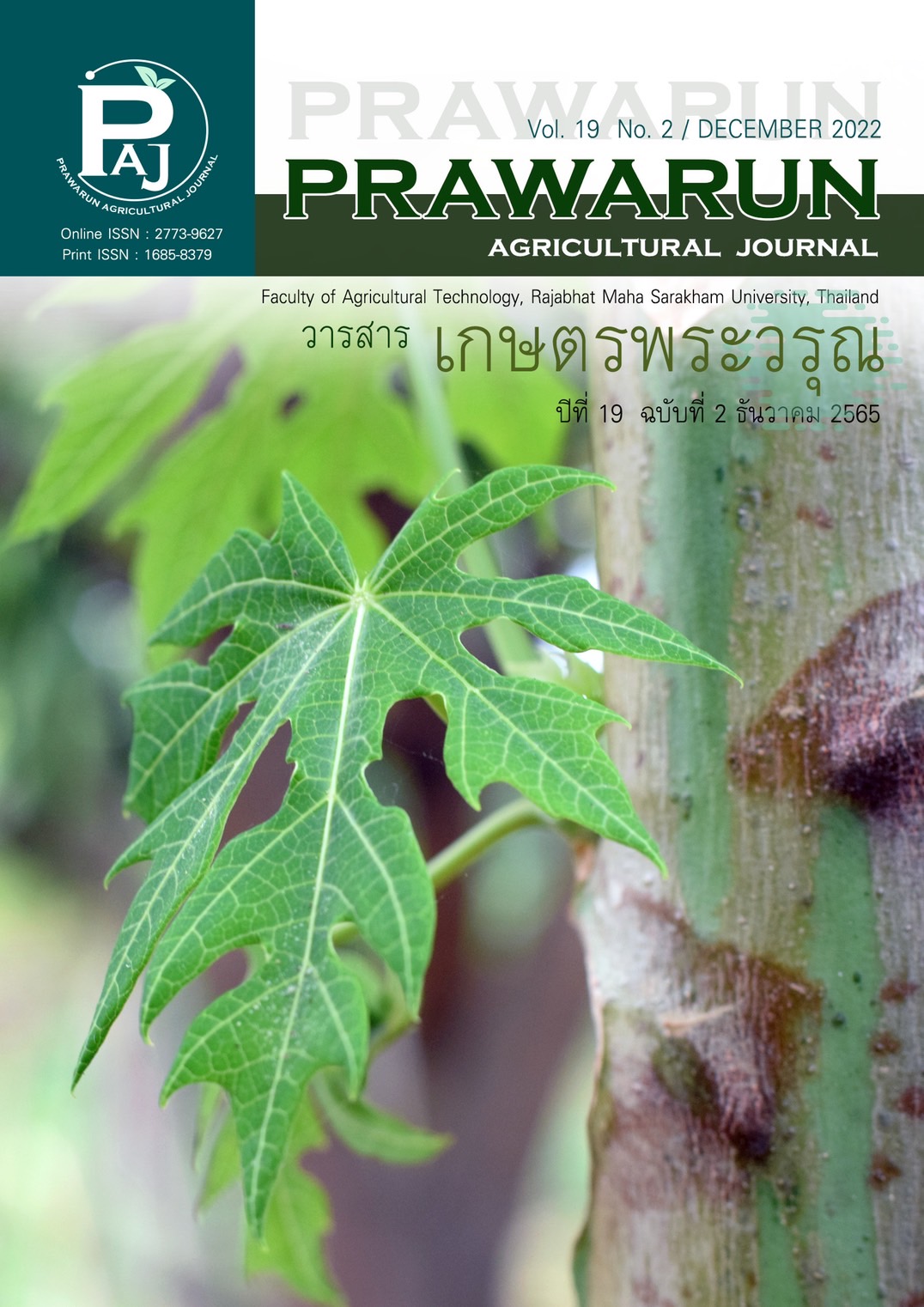เปรียบเทียบกายวิภาคและสมบัติของไม้ไผ่ 4 ชนิด จากจังหวัดกาญจนบุรี
Main Article Content
บทคัดย่อ
วัตถุประสงค์การวิจัยนี้เพื่อศึกษากายวิภาค และสมบัติของไม้ไผ่ โดยเก็บตัวอย่างไผ่ 4 ชนิด จากพื้นที่ปกปักพันธุกรรมพืช อพ.สธ. เขื่อนวชิราลงกรณ อ.ทองผาภูมิ จ.กาญจนบุรี ได้แก่ ไผ่บงใหญ่ (Dendrocalamus brandisii (Munro) Kurz) ไผ่มันหมู (Dendrocalamus copelandii (Gamble ex Brandis) N.H. Xia & Stapleton) ไผ่ผาก (Gigantochloa auriculata Kurz) ไผ่ข้าวหลาม (Schizostachyum pergracile (Munro) R.B. Majumdar) โดยเตรียมตัวอย่างด้วยอุปกรณ์ฝานชิ้นไม้ ศึกษาผ่านกล้องจุลทรรศน์แบบใช้แสง หาความหนาแน่น และความแข็งแรงของการดัดสถิตย์ (MOR) ที่ความชื้น 11 เปอร์เซนต์ ตามมาตรฐาน ISO ผลการวิจัยพบว่า ไผ่บงใหญ่ ไผ่มันหมู และไผ่ผาก มีชนิดของมัดท่อลำเลียงแบบเดียวกัน คือ Type III (broken-waist type) แต่แตกต่างที่ขนาดของมัดท่อลำเลียง ในขณะที่ไผ่ข้าวหลามมีชนิดของมัดท่อลำเลียงแบบ Type II (tight-waist type) ไผ่ผากมีค่าความหนาแน่น สูงที่สุด รองลงมาคือ ไผ่ข้าวหลาม ไผ่บงใหญ่ และไผ่มันหมู ตามลำดับ (0.8367, 0.7533, 0.6533, 0.4833 กรัมต่อลูกบาศก์เซนติเมตร) ในขณะที่ไผ่ข้าวหลามมีค่าความแข็งแรงของการดัดสถิตย์สูงที่สุด รองมาคือ ไผ่ผาก ไผ่บงใหญ่ และไผ่มันหมู (212.333, 192.550, 164.083, 102.570 เมกกะปาสคาล) เมื่อเปรียบเทียบความแตกต่างระหว่างค่าเฉลี่ยพบว่า ไผ่ข้าวหลาม และไผ่ผากมีความหนาแน่นสูงที่สุด รองลงมาคือ ไผ่บงใหญ่ ผลการศึกษาชี้ให้เห็นว่าไผ่ข้าวหลาม และไผ่ผาก เหมาะแก่การนำไปประยุกต์ใช้ในงานโครงสร้าง ได้แก่ ผลิตภัณฑ์ไม้อัด ไม้ลามิเนต และไม้อัดเกล็ดเรียงชิ้น
Article Details
เอกสารอ้างอิง
Anokye, R., Bakar, E. S., Ratnansingam, J., & Awang, K. B. (2016). Bamboo properties and suitability as a replacement for wood. Pertanika Journal of Scholarly Research Reviews, 2(1), 64-80.
Bhushan, U. K., Sharma, S. K., & Shukla, S. R. (2020). Optimization of pressing parameters of PF-bonded laminated bamboo lumber from Dendrocalamus brandisii. Journal of the Indian Academy of Wood Science, 17(2), 149-157.
Daram, S. (2019). The analysis of safety factor for bamboo used in construction. Journal of Architecture, Design and Construction, 1(3), 11-27. (in Thai)
Dixon, P. G., Ahvenainen, P. Aijazi, A. N., Chen, S. H., Lin, S., Augusciak, P. K., Borrega, M., Svedstrom, K., & Gibson, L. J. (2015). Comparison of the structure and flexural properties of Moso, Guadua and Tre Gai bamboo. Construction and Building Material, 90, 11-17.
Guerreiro, C., Rodriguez, M. F., & Agrasar, Z. E. R. (2013). Clum anatomy a contribution to the identification of vegetative Andean woody bamboos in southernmost America. Kew Bulletin, 68(2), 209-218.
Kaewbuadee, S., & Laemsak, N. (2014). Mechanical properties of bamboo culms from Phai Tong (Dendrocalamus asper) and Phai Chin (Dendrocalamus sinicus). Journal of Forest Management, 8(16), 30-38. (in Thai)
Kermanee, P. (2008). Techniques in plant tissue. Bangkok: Kasetsart university press. (in Thai)
Kiaokhong, B., & Doungpet, M. (1999). Laboratory manual for mechanical testing of wood. Bangkok: Kasetsart university press. (in Thai)
Laemsak, N., & Chotikhun, A. (2007). Properties of some bamboo culms planted at the Royal agriculture station Ankhang. Thai Journal of Forestry, 26, 68-74. (in Thai)
Laosakul, S., Boonsermsuk, S., & Sungkaew, S. (2014). Bamboos in Queen Sirikit park. Bangkok: Forest research and development office, Royal Forest Department. (in Thai)
Liese, W. (1998). The Anatomy of Bamboo Culms. Beijing: Art Options.
Mustafa, M. T., Wahab R., Sudin, M., Sulaiman, O., Kamal, N. A. M., & Khalid, I. (2011). Anatomical and microstructures features of tropical bamboo Gigantochloa brang, G. levis, G. scotechinii and G. wrayi. International Journal of Forest, Soil and Erosion, 1(1), 25-35.
Park, S. H., Jang, J. H., Wistara, N. J., Hidayat, W., Lee, M., & Febrianto, F. (2018). Anatomical and physical properties of Indonesian bamboos carbonized at different temperatures. Journal of the Korean Wood Science and Technology, 46(6), 656-669.
Sharma, B., Gatoo, A., Bock, M., & Ramage, M. (2015). Engineered bamboo for structural applications. Construction and Building Material, 81, 66-73.
Siam, N. A., Uyup, M. K. A., Husain, H., Mohmod, A. L., & Awalludin, M. F. (2019). Anatomical, physical and mechanical properties of thirteen Malaysian bamboo species. Bioresources, 14(2), 3925-3943.
Sungkaew, S., Teerawatananon, A., & Jindawong, K. (2011). Bamboo of Thailand. Bangkok: Amarin Printing & Publishing Public Co., Ltd. (in Thai)
Zakikhani, P., Zahari, R., Sultan, M. T. H., & Majid, D. L. (2017). Morphological, mechanical and physical properties of four bamboo species. Bioresources, 12(2), 2479-2495.


